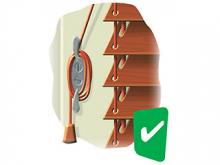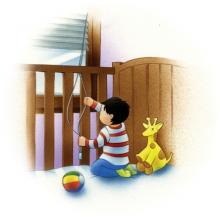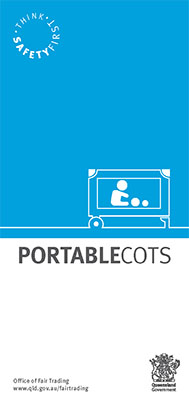Children can fall when trying to climb out of folding cots, or become trapped if a cot accidentally collapses. Make sure you buy a cot that meets the mandatory safety standard.
About folding cots
Folding cots, also known as portable cots, travel cots or portacots, are easily collapsible for transport. Folding playpens are also considered to be folding cots if they have a supportive base.
Risks and injuries
Young children can suffer serious injuries if they fall when trying to climb out of a cot by using footholds or objects left in the cot.
Folding cots generally come with a mattress, which may be part of the base. The extra depth produced by adding an aftermarket or additional mattress can create entrapment and suffocation hazards if it is poorly fitted or too soft.
Infants can become trapped and strangled if cots accidentally collapse when they are not properly assembled and locked into place, or if straps from attachments such as change tables, hang down into the cot.
To minimise risks, there is a mandatory safety standard for folding cots.
Buying tips
- Most modern folding cots come with a padded base or mattress. Only use what is supplied with the cot.
- If you need to buy a replacement base or mattress it is best to get one from the original supplier, which was designed for the cot.
- Look for folding cots with a locking device that cannot be operated by a child inside the cot.
- When buying folding cots, look for those that come with the required safety information and assembly instructions.
Safe use
- Folding cots that are designed to meet Australian standards can be a safe sleeping environment for infants when set up properly.
- Make sure you follow the instructions provided when assembling the cot.
- Keep children away from the cot during assembly to avoid potential injury.
- It’s safer to use folding cots that have a mattress designed for them. Adding an ill-fitting or extra mattress can create dangerous gaps that can trap a sleeping child or make the sleep surface too soft increasing the risk of suffocation.
- Never use inflatable mattresses or similar products with folding cots. These products are more likely to mould to the baby’s face and increase the risk of suffocation.
- Never place the cot near blinds and curtain cords. Infants have died after being strangled by loose blind or curtain cords hanging in or near cots. Similarly, keep decorative mobiles out of reach.
- Folding cots are subject to wear and tear due to repeated folding, unfolding and portability. They are generally less robust than permanent sleeping enclosures such as household cots, so they should be regularly checked for signs of damage and to make sure that the folding and locking mechanisms work correctly. Infants can be trapped and may be strangled if a cot collapses.
- Never place toys, sleep positioners or extra bedding like pillows, blankets and bumpers in a cot as these increase the risk of suffocation for babies. Make sure the cot is clear of these items before placing baby for sleep.
- Always remove cot accessories such as change tables and bassinette inserts when the cot is in use to avoid entrapment, entanglement, falling or other hazards for your child.
- Stop using cots once a child shows signs that they want to climb out of them. Children who can stand confidently in a cot, shake the sides and ends and attempt to climb are usually ready for a low bed or a toddler bed.
Videos






